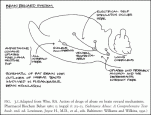The Addicted Brain
Only within the last several decades have we begun to understand why a person will use a substance compulsively, regardless of the consequences, even to the point of death.
The key to understanding this puzzling behavior lies in a series of discoveries made over the last forty years. In the 1950s it was learned that if a certain part of the brain is electrically stimulated, an intensely pleasurable sensation occurs.
In the 1960s researchers began to find receptors in the brain for opiate-like substances. Later in that decade the discovery was made that the brain produces opiate-like substances (endorphins), which explained the presence of the opiate receptors.
The Pleasure Center
As addiction has been studied in the past couple of decades, we have found that alcohol and every major class of drugs of abuse interact with the same part of the brain in one fashion or another. This part of the brain is the same one that produces the intensely pleasurable reaction to electrical stimulation that was noted in the 1950s. It is located in the lower central portion of the brain, the part that regulates automatic functions such as breathing and appetite. It is connected to the relay centers of the brain that include the thalamus and hypothalamus, as well as to higher parts of the brain such as the cortex, where most of our learning and reasoning take place. This part of the brain is called the ventral tegmentum and is part of a circuit known as the medial forebrain bundle.
It includes tracts of nerve cells called the mesolimbic tracts.
The primary purpose of this part of the brain seems to be to produce a pleasurable sensation when it is stimulated and to make sure that the higher parts of the brain remember what the stimulation was so that it will be repeated. This area is intertwined with parts important in memory and learning and with those which control appetite and sexual desire (fig. 3.1).
The cells that make up this area are rich in the same neurotransmitters (see below) which regulate emotion, and their fibers extend to and interact with the structure of the brain that mediates emotional tone (the limbic system).
It has been consistently demonstrated that drugs with addictive properties are active in the ventral tegmentum. In fact, one way in which researchers study addictive drugs is to stimulate that area in the brain of an animal and then observe its behavior. If the animal is hooked up to electrodes that it can learn to stimulate by pressing a lever, it will press that lever over and over - even in lieu of food - until it falls out in exhaustion. A researcher who hooks the animal up to a tiny infusing device that delivers a drug can see whether the animal pushes the lever in the same manner.
 fig. 3.1. Adapted from Wise, RA. Action of drugs of abuse on brain reward mechanisms.
fig. 3.1. Adapted from Wise, RA. Action of drugs of abuse on brain reward mechanisms.
Pharmacol Biochem Behav 1980; 13 (suppl 1): 213–23. (Substance Abuse: A Comprehensive Text-
book. 2nd. ed. Lowinson, Joyce H., M.D., et al., eds. Baltimore: Williams and Wilkins, 1992.)
If the animal does push the lever, the indication is that the infused substance is stimulating that area of the brain. The frequency with which the animal pushes the lever also measures the potency of the drug in question - the more it pushes, the stronger the effect of the drug.
This response to all the known drugs of abuse is so consistent that use of the technique has become standard practice in the testing of new drugs for addictive potential. If a researcher infuses the drug and the animal goes on behaving normally, then the drug is probably not addictive.
Elizabeth Connell Henderson, M.D.
Glossary
Appendix A: Regulation of Addictive Substances
Appendix B: Sources of Additional Information